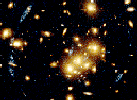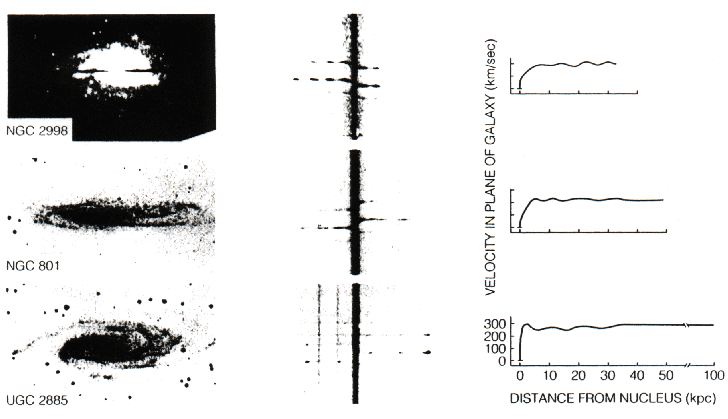Dark Matter in the Universe


| Gene Smith's Astronomy Tutorial Dark Matter in the Universe |
 |

Observations of clusters and their galaxies, have uncovered one of the major mysteries in astronomy today. Clusters appear to be very stable entities - they contain mature galaxies with old stars, and seem to have been formed billions of years ago. But, when we calculate the amount of mass in a cluster using the orbital motions of its member galaxies, the result is too low for the cluster to be gravitationally bound. If the cluster contains only the mass we can observe, the gravitational force is insufficient to prevent the galaxies from "escaping".There must be more mass in the cluster than what we see.

The same problem arises when we look at the galaxies themselves. The rotation curve of a galaxy shows how the orbital velocities of the stars change with distance from the center. If the galaxy rotated as a solid disk, the velocity would increase linearly with distance. If most of the mass were concentrated at the the center, as in our solar system, the velocities of the stars would decrease with the square root of the distance. But, that is not what is observed. Far past the point where no mass is visible, the rotation curves are flat! This means that the mass is still increasing as we move outward, even though we can't see anything! One again we have to call upon "dark matter". The galaxy must extend much farther out than the luminous matter indicates. In fact, the calculations require that there be at least 10 times more mass than we can see! Calculations suggest that this dark matter is likely to be in an extensive halo of dark matter.
The nature of this dark matter or "missing mass" is unknown. There are theories ranging from the bizzare to the mundane, none of which successfully answer all of the questions.
The most attractive possibility is that the Dark Matter lies in some form of compact non-luminous object:
 the
number of stars increases dramatically as you go to stars of lower mass. Does
this trend continue as one goes below the cutoff for the ignition of nuclear
reactions? If so, failed stars, called Brown Dwarfs, might account for
a significant fraction of the Dark Matter. Brown Dwarfs are hard to spot
since they are cool and very low in luminosity. Recent infrared studies are
finding Brown Dwarfs, but not in sufficient numbers to make up the dark matter
needed in the Milky Way.
the
number of stars increases dramatically as you go to stars of lower mass. Does
this trend continue as one goes below the cutoff for the ignition of nuclear
reactions? If so, failed stars, called Brown Dwarfs, might account for
a significant fraction of the Dark Matter. Brown Dwarfs are hard to spot
since they are cool and very low in luminosity. Recent infrared studies are
finding Brown Dwarfs, but not in sufficient numbers to make up the dark matter
needed in the Milky Way.
Perhaps galaxies have large amounts of gas that has not been accounted for. But, cool atomic hydrogen would emit 21-cm radio waves, and these are not seen. Molecular hydrogen should be visible by its ultraviolet emission, but this is not observed. Hot gas emits x-rays, and several galaxy clusters are strong x-ray sources. The mass of intergalactic gas is calculated to be a considerable amount, perhaps greater than the amount in galaxies and stars, but is still too little to account for the cluster stability.
According to the most commonly accepted theory, Big Bang Nucleosynthesis, ordinary atomic nuclei formed as the Universe expanded and cooled. The theory allows detailed calculations of the amount of helium (4He) produced (also 2H - deuterium, 3He, 4Li, 4Be, 4B) that should be present, and these have been confirmed by observations. But the theory only agrees with observation if the total amount of baryons (protons & neutrons) is restricted. There are enough baryons to account for some dark matter, but not enough to solve the problem.
If the "missing mass" isn't ordinary matter, we still have some plausible choices. New physics is not required. If neutrinos, a fundamental particle thought to be massless, actually do have mass, this could be significant. The current mass estimate for the electron neutrino, however, is only 1/100,000th the mass of the electron, suggesting that neutrino mass makes up a small fraction of the required dark matter. Or, there may be other weakly interacting, massive particles (WIMPs) as yet undiscoverd.

![]() Gravitational Lenses
Gravitational Lenses
![]() Clusters
Clusters
![]() Outreach & Education
Outreach & Education
![]() CASS Home
CASS Home
Comments?
Gene
Smith
Conducted by:
Prof. H. E. (Gene) Smith
CASS 0424 UCSD
9500 Gilman Drive
La Jolla, CA 92093-0424
Last updated: 26 April 1999